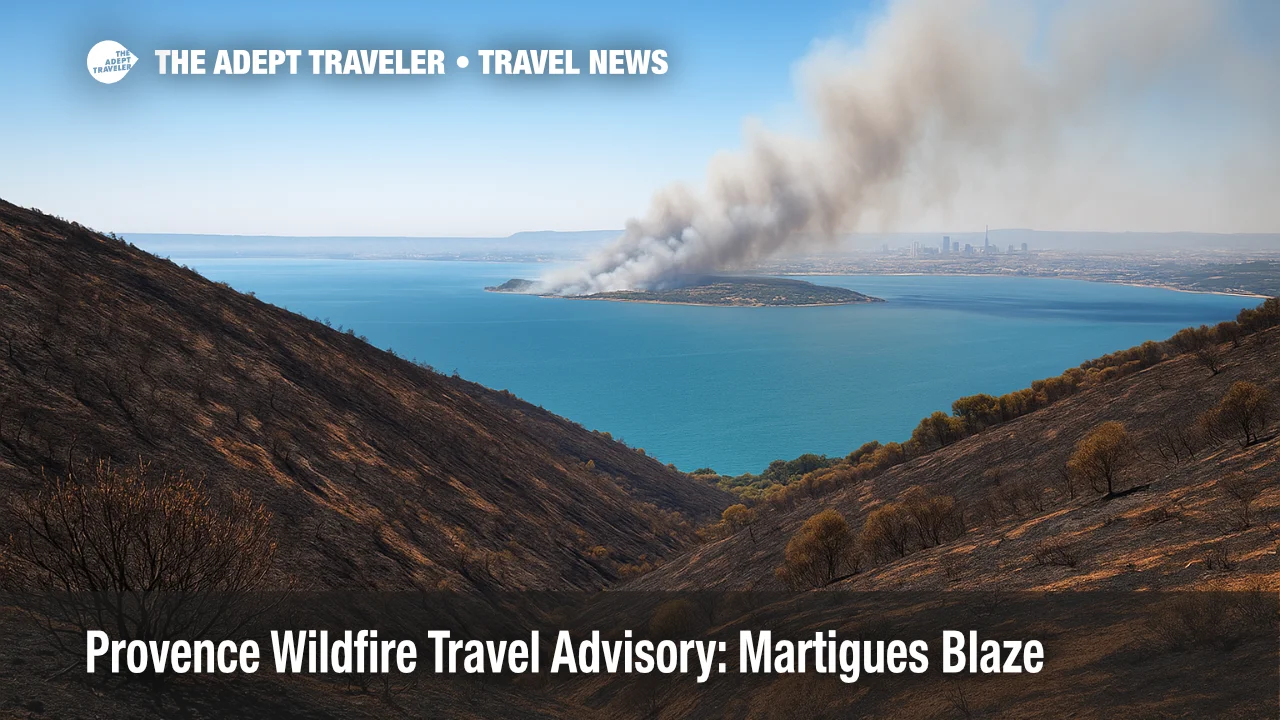Provence Wildfire Travel Advisory: Martigues Blaze

A fast-moving wildfire that ignited on July 18 has scorched roughly 240 hectares (about 593 acres) of Mediterranean scrub north of Martigues, just 25 miles from Marseille Provence Airport (MRS). Nearly 1,000 firefighters, six water-bombing aircraft, and dozens of engines remain on scene. Although cooler, more humid weather has slowed the flames, authorities warn that shifting winds could stir lingering hot spots and trigger new closures on regional roads and rail lines. Travelers bound for Provence should expect occasional detours, reduced air quality, and heightened fire-risk alerts through the coming week.
Key Points
- Why it matters: Martigues sits on the main A-55 coastal corridor linking Marseille to the Riviera.
- 240 ha burned; perimeter now contained but pockets remain active.
- 150 residents evacuated, 120 homes shielded by firebreaks; no fatalities reported.
- Intermittent closures on A-55 and D N568; TER regional rail delays up to 45 minutes.
- Smoke may reduce visibility at MRS, but all runways remain open.
- Asthmatics and travelers with heart or lung conditions should carry N-95 masks.
Snapshot
French civil-protection officials declared the Martigues fire "fixed" at 3 p.m. local time on July 20, meaning the perimeter no longer advances. Crews, however, must patrol a six-mile fire line for hidden embers and handle flare-ups each afternoon as sea breezes rise toward 20 mph. Ground teams have carved new dozer tracks behind homes in Saint-Mitre-les-Remparts, while water-bombers dampen the east flank above the Étang de Berre lagoon. Travelers will notice helicopter overflights, roadblocks that let emergency convoys pass, and an acrid haze that can obscure views of the Côte Bleue coastline.
Background
Southern France endures one of its driest springs in 50 years. From April 1 to July 15, Marseille logged just 2 inches of rain-40 percent below normal-and highs near 95 °F for nine days straight. The parched garrigue surrounding Martigues became tinder when mistral winds gusted past 30 mph on July 17. Sparks, likely from a roadside vehicle, leapt into brush along the D N568. Within two hours, flames crossed the highway, jumped a rail spur, and raced toward the Étang de Berre. Firefighters recalled the devastating 2020 Martigues fire and rapidly requested reinforcements from neighboring Var and Hérault departments, preventing a repeat sweep into beach subdivisions.
Latest Developments
Authorities lifted the last residential evacuation order at 10 a.m. on July 20, yet the département remains on orange wildfire alert until at least July 23.
Status of Firefighting Effort
Commanders from the Bouches-du-Rhône Fire and Rescue Service (SDIS 13) maintain 800 personnel overnight, rotating fresh crews by daylight. Six Canadair CL-415s perform continuous scooping runs over the Étang de Berre, dropping 1,600 gallons per pass. Bulldozer teams have widened control lines to 165 feet, meeting France's updated 2024 forest-fire code that requires double the buffer near high-risk communities.
Road and Rail Disruptions
The A-55 remains open but may close without notice between Exits 9 and 11 for hose lays across pavement. Drivers should monitor Bison Futé advisories and keep an extra gallon of water in the car in case traffic stalls. TER Occitanie trains between Miramas and Marseille run on a single track through the burn zone, causing delays of 30-45 minutes during peak tourist hours. Marseille's RTM bus route 34 detours via Carry-le-Rouet.
Air Quality and Health Advice
Smoke concentrations reached 120 µg/m³ PM2.5 on July 19-well above the World Health Organization's 24-hour guideline of 15 µg/m³. Levels fell below 40 µg/m³ after a sea-breeze shift but can spike each evening. Travelers with asthma should carry rescue inhalers and consider staying inland if visibility drops below 2 miles. Marseille Airport Wildfire Closure: What Travelers Need to Know on The Adept Traveler details MRS's contingency plan for smoke incursions.
Analysis
Wildfire season increasingly overlaps with Provence's peak visitor surge, raising the stakes for destination management. Vacationers who book hideaways along the Côte Bleue often rely on a single coastal highway and limited rail service. Any closure can add two hours to the 40-mile drive between Marseille and Aix-en-Provence, straining rental-car inventories and forcing tour operators to reroute day trips to Arles or the Luberon. Cruise lines home-porting in Marseille may adjust shore-excursion timing if buses face smoke-related detours. Hotels north of Martigues report scattered cancellations, but city-center properties in Marseille remain largely unaffected. Advisors should track prefectural bulletins, arrange flexible transfer windows, and warn clients that Provence sunsets could appear hazy, limiting photography at iconic lavender fields.
Final Thoughts
The Martigues blaze underscores how quickly drought and wind can disrupt even well-traveled corners of France. While firefighters have contained the perimeter, travelers should pack face masks, download real-time traffic apps, and stay ready to pivot plans if smoke drifts or roads close. With vigilance, flexibility, and the latest guidance, a Provençal summer can still deliver its trademark markets, vineyards, and seaside charm-just keep this Provence wildfire travel advisory top of mind.
